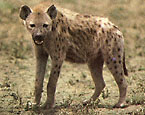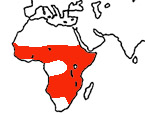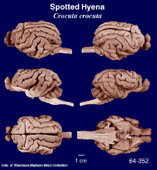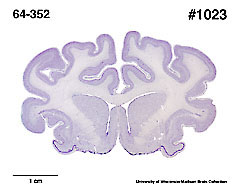|
Spotted
Hyena
(Crocuta crocuta) #64-352 |
||||
|
|
Physical
characteristics and distribution
|
|
The largest and best-known member of the hyena family, the Spotted Hyena (Crocuta crocuta) is primarily a predator, not a scavenger. Individuals have been clocked at over 55 kilometres per hour (34 mph), and when hunting in packs are capable of taking down the largest of prey. Spotted Hyenas have such formidable jaws (one of the strongest in the animal kingdom) and teeth that they devour even the bones of their kill. The hyena's distinctive laughing call, used to disorient prey and gather the pack, has resulted in their nickname "laughing hyena". Adult females, weighing up to around 72 kilograms (158 lb), are heavier than the males, which are typically 10 kilograms (22 lb) lighter. Female Spotted Hyenas are larger than their male counterparts, and socially dominant over them. Males leave their natal group on reaching sexual maturity, while females remain in it; the society is highly structured, with dominance relationship between the matrilines (the groups of females descended from a single mother) that endure for generations. The female Spotted Hyena's urogenital system is unique among mammals: there is no vagina, and the clitoris is as large and as erectile as the male's penis - only the shape of the glans makes it possible to tell the sexes apart. The female urinates, mates and gives birth through this modified clitoris (it contracts for mating, the opening widening to admit the male's penis). In the wild, survival rates of females seem to fall sharply around the age of first giving birth, suggesting that the process is hazardous for the mother also. This suggests that at some point there must have been powerful selective pressures driving the evolution of masculinisation. While Spotted Hyenas have no real predators (besides humans), they are on occasion killed by lions, which eat the same foods and will often clash with hyenas over kills. The explanation for this competition is that lions and spotted hyenas are of the same guild. Although lions are much larger, hyenas will defend their kills if possible, and hyena packs have been known to kill lions if they outnumber them significantly. Spotted Hyenas live in the savannas and deserts, in clans averaging 40 individuals - with some as large as 100. They are now found in Angola, Botswana, Camerooon, Dem. Rep. Congo, Ethiopia, Gabon, Gambia, Guinea, Kenya, Malawi, Mauritania, Mozambique, Namibia, Nigeria, Senegal, Sierra Leone, Somalia, South Africa, Sudan, Tanzania, Togo, Uganda, Zambia, Zimbabwe. |
|
Description
of the brain
|
|
Animal
source and preparation
|
|
All
specimens collected followed the same preparation
and histological procedure.
|
Other Related Resources (websites and publications)
List of Specimens | Explore Collections | Brain Sections | Brain Evolution | Brain Development | Brain Circuitry | Brain Functions | Location and Use | Related Web Sites | Contact Us | Search MSU Database | Personnel | Home



